The Big 3 Baitfish Spawns
Spawning baitfish create solid opportunities to target bass. Making the most of them begins with understanding the bait’s spawning behavior and whereabouts.
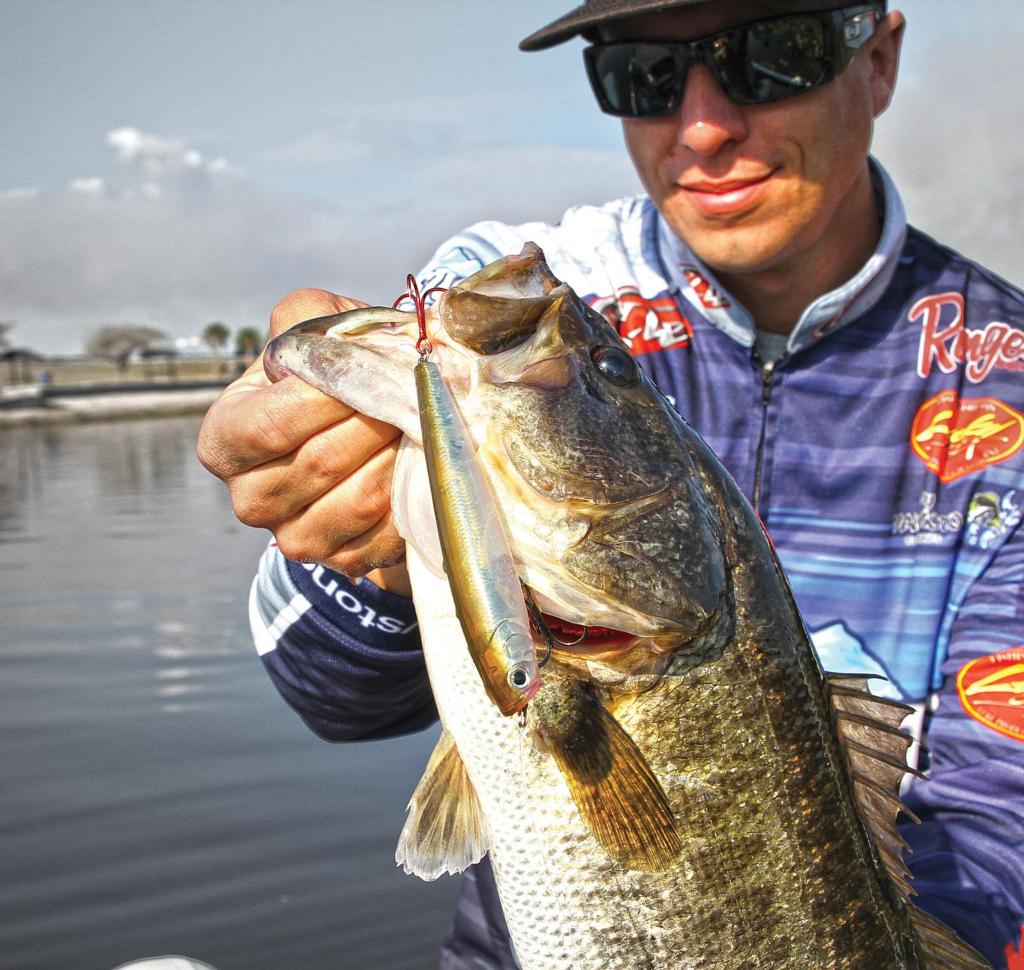
(Editor’s note: This article originally appeared in the 2013 May/June issue of Bass Fishing magazine. To read more compelling articles from Bass Fishing magazine each month, become an FLW subscriber member. If you’d like to sign up for a digital subscription to access articles online, click here).
If you’ve ever toted a plate of cupcakes into a room filled with children, set the cupcakes down and watched what happened next, you can imagine what occurs when the forage species of bass spawn. The bass soon figure out that their favorite foods are congregated and captivated, and they show up for the feast.
Anglers who learn to recognize and capitalize on major baitfish spawns enjoy some of the best action of the year, so we spoke with pros who are experts on fishing the shad, blueback herring and bluegill spawns to see how they capitalize on the opportunity.
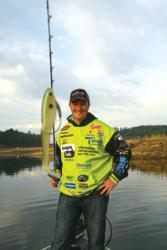 The Shad Spawn: Scott Canterbury Makes the Most of the Morning
The Shad Spawn: Scott Canterbury Makes the Most of the Morning
Is It in Play?
“You can’t miss it when it’s happening,” says Straight Talk pro Scott Canterbury. “It’s about as exciting as fishing gets. You see shad everywhere as the bass are busting bait on the surface, you feel shad bumping into your lure and trying to spawn with it, and you’re catching fish – all at once.”
If bass have been spawning and the water temperature is rising, Canterbury goes looking for spawning shad in the morning. He searches likely banks for shad and watches for bass among them. If the shad are spawning, then the bite is on, as far as Canterbury is concerned. However, he only focuses on it if he has the opportunity to hit spots first thing in the morning.
Fishing Strategies
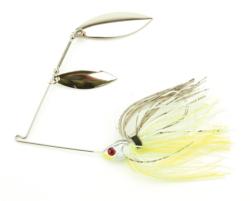 Canterbury’s default lure is a spinnerbait, usually white with a hint of chartreuse and oversized willow-leaf blades. Even so, he stays ready with several lures, including swim jigs, vibrating jigs, topwater lures and hollow-bodied swimbaits, and switches up if needed.
Canterbury’s default lure is a spinnerbait, usually white with a hint of chartreuse and oversized willow-leaf blades. Even so, he stays ready with several lures, including swim jigs, vibrating jigs, topwater lures and hollow-bodied swimbaits, and switches up if needed.
“Topwater can be tough to beat when it’s really happening,” he adds. “I like a walking bait – maybe a Jackall Mud Sucker or Bowstick – or a popper, like an SK-Pop.”
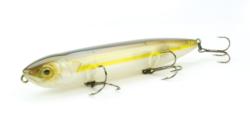 Common denominators among all of Canterbury’s shad-spawn lures are shapes, flash and/or colors that mimic the baitfish, and great action when fished quickly.
Common denominators among all of Canterbury’s shad-spawn lures are shapes, flash and/or colors that mimic the baitfish, and great action when fished quickly.
Tournament Strategy Points
Except on the rare overcast days when the shad spawn is extended, it all happens first thing in the morning and often ends as quickly as it begins. It’s critical to know the banks where shad are likely to pop up and to work them efficiently. Have a route planned and rods rigged.
“I want to cover as many spots as possible while it’s happening,” Canterbury says. “If I pull up on a bank and don’t see the shad or don’t get hit, I won’t stay in that spot more than a few minutes.”
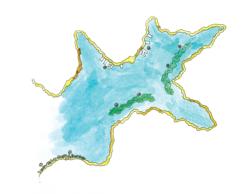 When the shad stop spawning any given morning, the baitfish and bass just seem to disappear, and the bass become far more difficult to catch.
When the shad stop spawning any given morning, the baitfish and bass just seem to disappear, and the bass become far more difficult to catch.
“I once caught 24 pounds in the first hour of a tournament and never got another bite that day,” Canterbury says.
Although Canterbury doesn’t believe the bass move very far, he doesn’t continue targeting those fish, instead perhaps looking for remnant spawning bass or going offshore in search of a kicker that spawned earlier and has moved out.
When It Happens
– Normally soon after the peak of the bass spawn
– When the water temperature is between mid-70s and low 80s
– At first light, sometimes for little more than an hour but lasting longer on extra dark days
– Peaks during full and new moons, but occurs throughout moon cycles
Where It Happens
– Shad spawn near the bank, usually in creeks and pockets, but some times in the main lake.
– Look in the extreme shallows out to about 12 feet deep in most lakes.
– Most activity occurs around cover, often including new hydrilla growth, emergent vegetation, floating dock supports and riprap banks.
– Location types, depths and cover types vary from lake to lake, but often are the same throughout a given lake.
– The same spots hold spawning shad morning after morning during the spawning season.
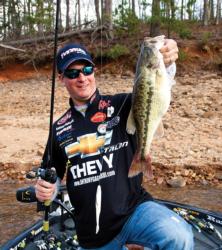 The Blueback Herring Spawn: Anthony Gagliardi Takes a Patient Approach
The Blueback Herring Spawn: Anthony Gagliardi Takes a Patient Approach
Is It in Play?
The first step is to simply search for the herring themselves in likely areas. The best spots are shallow, so it’s usually easy to locate dense schools of baitfish.
“You’ll also see them following your baits back if they’re there,” says Chevy pro Anthony Gagliardi.
Just because the bluebacks are on a point doesn’t mean that the bass are with them and that the herring bite is in play, though. If the bass spawn is peaking, for example, fewer fish will show up for the herring buffet. If the herring and bass are together, you’ll know it. You’ll see bass darting among the baitfish and busting them atop points, especially early in the morning. If your presentations are true, you’ll probably catch them.
Fishing Strategies
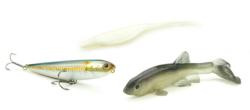 “I’ll usually start with a topwater lure,” Gagliardi says. “You want something that moves pretty fast, like a [Lucky Craft] Sammy or a Gunfish.”
“I’ll usually start with a topwater lure,” Gagliardi says. “You want something that moves pretty fast, like a [Lucky Craft] Sammy or a Gunfish.”
If the fish won’t come up, good subsurface options include swimbaits and soft-plastic jerkbaits in natural or herring color patterns.
Because blueback herring get a lot of attention, the bass feeding on them get pressured quickly and definitely get fussier a couple of weeks after they start keying on the herring. At times it takes a different look to get them to bite, so Gagliardi experiments with various lures as the season progresses. The trick is finding something different that still imitates a herring and lends itself to quick presentations in shallow water.
Tournament Strategy Points
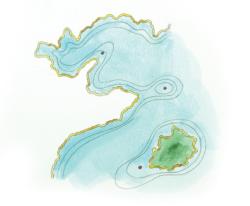 “It can become a boat number game,” Gagliardi says. “When it’s really on, those fish get a lot of pressure. Everybody finds the best groups, so a lot of guys are competing for the same spots and using the same types of techniques.”
“It can become a boat number game,” Gagliardi says. “When it’s really on, those fish get a lot of pressure. Everybody finds the best groups, so a lot of guys are competing for the same spots and using the same types of techniques.”
The peak definitely occurs early in the morning, so getting to the right group of fish right away and making good presentations during that peak window are critical steps to success. Another trick is to figure out how to catch bass from the same school throughout the day.
“The herring seem to move out during the day, and I’m not sure where they go,” Gagliardi says. “Some bass will just stay in the same spots, probably waiting for the herring to return at night or early the next morning, and sometimes you can catch them with a finesse lure like a shaky head.”
Also, timing can be a critical issue. Bass often prowl the outskirts of a school of herring, until one bass pursues and feeds on the bait, which ignites a brief frenzy of feeding. To capitalize, patient anglers often wait in one spot for the frenzy to occur. Anglers wired to move rotate through a milk run of blueback spawning areas in hopes of coming across an active feeding situation.
When It Happens
– Peaks when water is between 59 and 65 degrees
– Strong morning activity, but will last all day
– Sometimes occurs significantly sooner
– Usually during the largemouth spawn, or immediately after it
Where It Happens
– Check long, flat points, including secondary points and main-lake points.
– Hard bottoms are generally best.
– Most activity occurs in shallow water, usually 3 or 4 feet deep, but often well out from a bank, atop shallow structure.
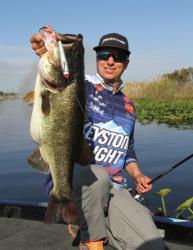 The Bluegill Spawn: Brent Ehrler Plies Shallow Pockets
The Bluegill Spawn: Brent Ehrler Plies Shallow Pockets
Is It in Play?
“If the bass have spawned, I’m going to be looking for it [the bluegill spawn],” says Keystone Light pro Brent Ehrler, “especially if I’m on a lake like Ouachita or a lot of the lakes in the Carolinas where the bluegill spawn tends to be important.”
While a few bluegills might form beds concurrent with the bass spawn, the bluegill spawn bite heats up after the bass spawn, when the bass are feeding again and seeking to replenish calories.
For Ehrler, figuring out whether the bluegill spawn will be a factor is simply a matter of physically looking for beds in the backs of pockets where he’d expect bluegills to spawn and throwing the right types of lures. If the bass respond, it’s in play, and he’s going to do more of it.
Fishing Strategies
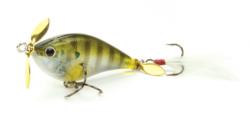 “There are a couple topwater lures that have to be used,” Ehrler says. “One is a walking bait like a [Lucky Craft] Gunfish 115. The other is the Brians Bees Prop Bee that is so famous for that type of fishing.”
“There are a couple topwater lures that have to be used,” Ehrler says. “One is a walking bait like a [Lucky Craft] Gunfish 115. The other is the Brians Bees Prop Bee that is so famous for that type of fishing.”
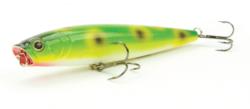 Ehrler uses the Gunfish as a search bait, hitting the backs of a bunch of pockets and making many casts in search of bass that are actively feeding on bedding bluegills. Once he finds fish, he fishes that area thoroughly with the prop bait, which he fishes very slowly.
Ehrler uses the Gunfish as a search bait, hitting the backs of a bunch of pockets and making many casts in search of bass that are actively feeding on bedding bluegills. Once he finds fish, he fishes that area thoroughly with the prop bait, which he fishes very slowly.
 He also works the same areas with a Yamamoto Senko, rigged wacky style on a Gamakatsu split-shot/drop-shot weedless hook.
He also works the same areas with a Yamamoto Senko, rigged wacky style on a Gamakatsu split-shot/drop-shot weedless hook.
“There’s a lot of brush and other cover that the bluegills get around in the backs of those coves, and so having that weedless presentation makes a big difference,” Ehrler says. “I find that the wacky rig presentation produces best in that situation.”
Tournament Strategy Points
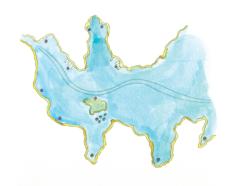 “It’s definitely a timing thing, but it’s not timing that you can predict,” Ehrler says. “The bass seem to cruise in wolf packs, because you can fish a spot and not get a bite or even see a bass and then return to that spot a couple of hours later and catch several, with fish busting all around.”
“It’s definitely a timing thing, but it’s not timing that you can predict,” Ehrler says. “The bass seem to cruise in wolf packs, because you can fish a spot and not get a bite or even see a bass and then return to that spot a couple of hours later and catch several, with fish busting all around.”
A good bluegill spawn pattern definitely can be run all day long. It’s a milk run sort of a pattern, where you identify a bunch of similar spots and keep moving from one to the next, returning to the same spots throughout the day.
“You’ll pick up singles here and there, but eventually you’ll hit a spot where they are in there and feeding well,” Ehrler says.
When It Happens
– Any time of day
– Spring through summer
– Strongest during full and new moons
– Begins concurrent with or just after the bass spawn
Where It Happens
– Most beds are made in the very backs of pockets.
– Sand, grit or another somewhat hard bottom is ideal.
– Beds are mostly in visible depths of less than about 5 feet, but some bluegills spawn substantially deeper.
– Buckbrush, docks supports, vegetation and other types of cover often attract bluegills to bed nearby.
SIDEBAR
Finding the Right Prop Bait
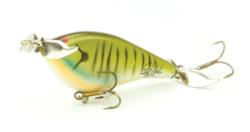 The range of prop baits pros have to choose from is expansive. Keystone Light pro Brent Ehrler says he consistently relies on two: the plastic Lucky Craft Kelly J and the balsa Brians Bee Prop Bee, which is one of the most popular among tour anglers due to its construction.
The range of prop baits pros have to choose from is expansive. Keystone Light pro Brent Ehrler says he consistently relies on two: the plastic Lucky Craft Kelly J and the balsa Brians Bee Prop Bee, which is one of the most popular among tour anglers due to its construction.
“It’s about the buoyancy because it’s made from balsa,” says Ehrler.
The Prop Bee’s buoyancy helps the lure stay level and ride high on the surface when Ehrler moves it with quick little snaps or series of snaps.
“Bass will swim right up below it while it’s paused, almost touching it, but stopping,” he says. “Then, when you give it a tiny twitch, they just crush it.”
The Prop Bee propellers also spin a little less freely than those on the Kelly J, which adds resistance and splash, and creates the kind of the commotion Ehrler desires for that situation.
“They look alike, but you’re really talking about two very different lures,” Ehrler adds. “I use the Kelly J to slow a presentation because the front end digs a little when you twitch it and brakes the movement. At the opposite end, I also like to swim the Kelly J steadily on top, like a buzzbait.”